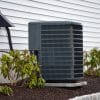If you live in a place where the summer heat is unbearable, you might be wondering how to cool down your room without a window. Maybe you have a basement, an attic, or a windowless office that needs some fresh air. Or maybe you just don’t want to deal with the hassle of installing a window air conditioner.
You can use an air conditioner without a window if you have another way to vent out the hot air. There are different types of ACs that can work in windowless rooms, such as central air, evaporative coolers, through-the-wall, and ductless mini-split air conditioners.

In this article, we will explain how they work, what are their pros and cons, and how to choose the best one for your situation.
Types of Air Conditioners for Windowless Rooms
Here are a few types of air conditioners that can be used in rooms without windows:
1. Central Air Conditioner

A central air conditioner is a type of air conditioner that cools the entire house through a network of ducts and vents. It has a large outdoor unit that contains the compressor and condenser, and an indoor unit that contains the evaporator coil and blower.
Pros
- They provide consistent and uniform temperatures throughout the house.
- They filter and dehumidify the indoor air, improving the air quality and comfort level.
- They operate quietly and discreetly, as they have no visible or noisy units inside the house.
- They can be combined with a furnace or a heat pump to provide heating in winter.
Cons
- They require HVAC installation if there is no existing system in the house, which can be extremely costly
- They consume more energy and increase the electricity bill, as they cool the whole house regardless of occupancy or preference.
- They may lose efficiency and performance due to duct leaks or blockages.
- They may not be compatible with some older homes or architectures that lack ductwork.
- Central AC repair is often more expensive
2. Evaporative Cooler
An evaporative cooler or ventless air conditioner uses a similar mechanism as the ice cube trick. It has a tank of water and ice that cools down the air by evaporating the water. It also has a fan that circulates the cold and moist air into the room.
Evaporative coolers are best suited for dry climates with low humidity and high heat, such as the West, Southwest, and Pacific Northwest. They can lower the temperature by up to 20 degrees Fahrenheit and add some humidity to the dry air.
Pros
- They are eco-friendly and energy-efficient, as they use water instead of refrigerant and electricity.
- They are easy to use and maintain, as they only require water and ice refills.
- They are quiet and lightweight.
Cons
- They are not effective in humid climates, as they add more moisture to the already damp air.
- They may cause mold or mildew problems if not cleaned regularly.
- They do not cool as much as other types of air conditioners.
3. Through-the-Wall Air Conditioner
A through-the-wall air conditioner is the closest to traditional window air conditioners. It has a metal sleeve that fits into a hole in the wall and a unit that slides into the sleeve. It has two fans: one that blows cold air into the room and one that blows hot air outside.
Through-the-wall air conditioners are more permanent and stable than portable or window units. They do not take up any floor or window space and do not need any venting hoses. They are also more efficient and powerful than portable units.
Pros
- They are durable and reliable.
- They are aesthetically pleasing and discreet.
- They can cool large rooms or spaces.
Cons
- They require professional AC installation and cutting a hole in the wall.
- They are expensive and may need additional insulation or support.
- They may not fit on some walls or match with some decor.
4. Ductless Mini Split Air Conditioner

A ductless mini split air conditioner is the most advanced and versatile type of air conditioner for windowless rooms. It consists of an outdoor unit that contains the compressor and an indoor unit that contains the air handler. The two units are connected by a thin conduit that carries the refrigerant and electrical wires.
A ductless mini split air conditioner can cool one or more rooms without the need for ductwork. It can also provide heating in winter by reversing the refrigerant flow. It has a variable-speed compressor that adjusts the cooling and heating capacity according to the demand, making it more efficient and comfortable than other types of air conditioners.
Pros
- They are highly efficient and energy-saving, as they avoid duct losses and only operate when needed.
- They are flexible and customizable, as they can cool or heat multiple zones with different temperatures and preferences.
- They are quiet and sleek, as they have no noisy fans or bulky units inside the room.
Cons
- They are costly and complex to install, as they require professional installation and wiring.
- They may require regular maintenance and cleaning, as they have filters and coils that can accumulate dust and debris.
- They may not be compatible with some home designs or aesthetics, as they have visible indoor units on the wall or ceiling.
How to Choose the Best Air Conditioner for Your Windowless Room
Now that you know the different types of air conditioners that can work in windowless rooms, how do you choose the best one for your situation? Here are some factors to consider:
1. The size and layout of your room
You need to measure the square footage of your room and check the cooling capacity of the air conditioner you want to buy. The cooling capacity is measured in BTUs (British Thermal Units) per hour and indicates how much heat the unit can remove from the air.
Generally speaking, you need about 20 BTUs per square foot of space, but this may vary depending on other factors such as ceiling height, insulation, sun exposure, etc.
2. The climate and humidity level of your location
You need to choose an air conditioner that can handle the temperature and humidity level of your location. For example, if you live in a dry climate with low humidity and high heat, you may benefit from an evaporative cooler that can add some moisture to the air.
On the other hand, if you live in a place with high humidity and moderate heat, you may prefer a through-the-wall air conditioner that can dehumidify the air and make it more comfortable.
3. The installation and maintenance requirements
If you are living in an apartment building with strict regulations when it comes to installing ACs, you need to consider ACs that don’t require an outdoor unit like a condenserless air conditioner.
You also need to consider how often you need to clean or replace the filters, coils, water tank, or drain hose of the air conditioner to keep it running smoothly.
4. The cost and energy efficiency of the air conditioner
Central air is extremely costly compared to other options if your home doesn’t have an existing HVAC system. But it can be more efficient when providing cool air for a large space for an extended period of time.
If you just need occasional cooling, a ductless mini-split is recommended since it doesn’t require ducts and vents to work.
Make sure to check the SEER (Seasonal Energy Efficiency Ratio) rating of the air conditioner, which indicates how much cooling output it provides per unit of electricity consumed. The higher the SEER rating, the more efficient the air conditioner is.
The Bottom Line
You can enjoy the cool air in your room, even if there is no window. You just need to find a suitable type of AC that works in windowless spaces like ductless mini-split ACs, evaporative coolers, and through-the-wall ACs. There are different types of air conditioners that can work in windowless rooms, such as evaporative coolers, and through-the-wall air conditioners. Each type has its own pros and cons, depending on your needs and preferences to choose one that suits your needs.



